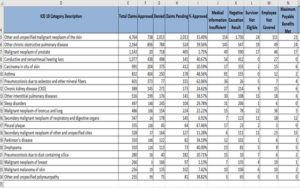
CWP Blog | CWP
Talk to Terrie: Top Diseases Claimed Under EEOICPA
April 5, 2021
April 5, 2021
CWP
CWP Blog
Some of you were interested in which diseases where the most common to be claimed as being the result of exposure to toxic substances through the Division of Energy Employees Occupational Illness Compensation (DEEOIC).
DEEOIC published a spreadsheet that provides statistics the top diseases claimed as well as statistics for seven disease categories.
You can access the spreadsheet by clicking on this link and then clicking on the third bullet “Top Medical Conditions Filed Under Part E from 2016 to September 2019.
Additional DEEOIC Program Information | U.S. Department of Labor (dol.gov)
Below is a screen shot of the top 20 diseased that were filed during this time period. What I found interesting is the percentages approved or denied. For instance, the disease with the highest approval rate is pleural plaque with an approval rate of 67.46%. On the other hand, the approval rate for malignant neoplasm of the breast is only approved 1.13% of the time. It’s important to remember that under Part E radiation exposure for cancer claims will only be approved if the National Institute for Occupational Safety and Health (NIOSH) determine that the probability that radiation was responsible for the development of the cancer or if the worker is a member of the Special Exposure Cohort. Cancer claims can be approved under Part E if a link between a cancer and exposure to a toxic substance other than radiation.
The nice thing about the spreadsheet is that DEEOIC explains the general reason a claim was denied. Most claims were denied because a link could not be made between exposure to a toxic substance and the resulting disease. According to DEEOIC’s regulations a decision to approve a claim will consider,
- The nature, frequency and duration of exposure of the covered employee to the substance alleged to be toxic;
- Evidence of the carcinogenic or pathogenic properties of the alleged toxic substance to which the employee was exposed;
- An opinion of a qualified physician with expertise in treating, diagnosing or researching the illness claimed to be caused or aggravated by the alleged exposure; and
- Any other evidence that OWCP [Office of Workers’ Compensation Programs] determines to have demonstrated relevance to the relation between a particular toxic substance and the claimed illness.
DEEOIC has made it easier for some claimants to be approved by accepting the recommendation from the Advisory Board on Toxic Substances and Worker Health’s to presume that certain labor categories would have been exposed to asbestos, for example. For other claims, DEEOIC will send the claim to an industrial hygienist for an opinion on the level of exposure level to toxic substances a worker may have received. This information is then sent to DEEOIC’s contract medical consultant to determine if those levels would have been sufficient to result in a disease.

